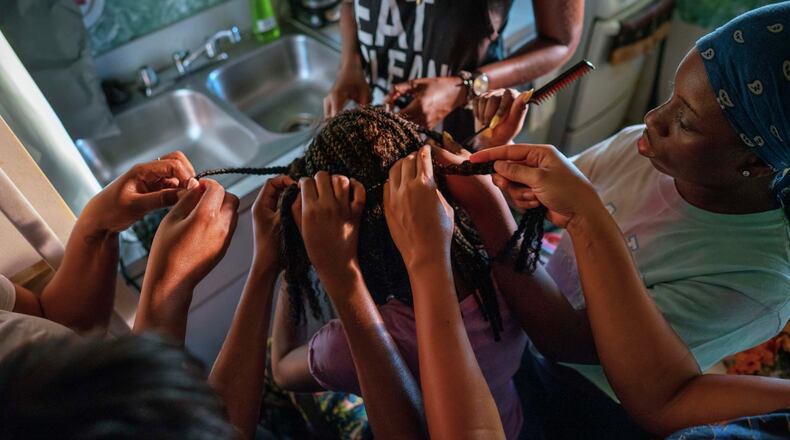Generous tax incentives have made the South a desirable film location with more movies shot in the past few years in places like Georgia, Louisiana and North Carolina than in the movie capital of California.
While the South is an advantageous shooting location, it is also often a character in American films, replete with conventions to be challenged or affirmed. The South as it is seen in film is the subject of photographer Alex Harris’s exhibition at the High Museum “Our Strange New Land.”
The good news in “Our Strange New Land” is there is not a Confederate flag or a plantation in sight. A Southerner himself, Harris knows that the contemporary South is far richer, more interesting and nuanced than those cliches.
A professor for more than three decades at Duke University’s Center for Documentary Studies, Harris’s absorbing photos document 41 small, independent productions from Austin, Texas, to North Carolina. Harris photographs the actors and landscapes that will appear on film. But he also pulls back even further to document the tattooed and baseball cap-outfitted male and female crew members working on the sets, positioning spotlights or scrambling up a ladder to record a shot.
“Our Strange New Land” is part of the “Picturing the South” project, a series inaugurated by the High Museum in 1996 in which notable photographers including Dawoud Bey, Martin Parr, Sally Mann and Alec Soth have been commissioned to create fresh perspectives on a region that could certainly use a visual reboot. Too often stereotyped and romanticized in movie storytelling, Harris’s photographs hint that a new breed of filmmakers is looking at the region through a different lens.
Many of Harris’s images suggest a South engaged in a kind of reckoning with matters of race, class and sexuality. It’s something many film fans have already noticed: that film has become far more diverse, complex and thus more interesting in recent years as it begins to reflect a broader range of experiences, especially in depicting black lives. In recent years films and TV shows like “Atlanta,” “Moonlight,” “The Florida Project” and this year’s “Waves,” “Burning Cane” and “Just Mercy” have focused on a grittier, more authentic side of Southern life not always treated in films set in the region.
In some cases, like an image of a black child climbing a palm tree against a stormy Florida sky from the film “Liberty,” the South is part of the story.
Other films, like the “Stepford Wives”-style comedy “Greener Grass” filmed in Peachtree City and Gay, Georgia, take the region as a locale, but don’t necessarily engage with the South as a subject.
And many images in “Our Strange New Land” feel more resonant as documents of the indie film scene, with its bearded, hipster gaffers and crafty budget-dependent improvisations and seem less about regionality.
What Harris does effectively in the exhibition is exploit the mystery of these fragmented narratives — little nuggets of visual information that leave us guessing about why the black cop and the white cop holding a drawn gun are facing off in “Thunder Road” or pondering the troubled expression of a pretty redhead sitting at her dining room table in “Doodle.”
Though different in intent, Harris’s images scratch the same itch of film stills — playing upon our sense of curiosity.
Along with his photographs, Harris has created a 22-minute three-channel video that shows a succession of Harris’s film-set still images. By juxtaposing the images, Harris has created a film montage of sorts that explores repeated gestures, shared color palettes or similar landscapes. An analysis of the language of film where certain conventions tend to repeat, it’s probably the most exploratory, promising work in the show. It moves beyond documentary into a new realm. It feels like both a cogent study of human behavior and how that reality is repackaged in movies.
Art review
“Our Strange New Land: Photographs by Alex Harris”
Through May 3, 2020. 10 a.m.-5 p.m. Tuesdays-Thursdays and Saturdays; 10 a.m.-9 p.m. Fridays; noon-5 p.m. Sundays. $14.50, ages 6 and above; free, children 5 and younger and members. High Museum of Art, 1280 Peachtree St., N.E., Atlanta 404.733.4444, www.high.org
Bottom line: Documentary photographs of Southern film productions sometimes deliver a new take on Southern cliches.
About the Author
Keep Reading
The Latest
Featured





